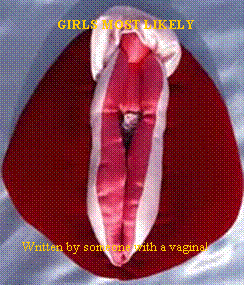Girls Most Likely
God, this really has to stop. I do not want to see any more legs and feet on the covers of books written by women. If an alien culture drew conclusions about us based on our cover art alone, they would unanimously agree that our civilization was ruled by podiatrists.
Look at this. Here’s a book of Christian fiction by Judy Baer:
And here’s the book from blogger Mimi Smartypants:
And here’s the cover of Sheila Williams’ latest novel Girls Most Likely:
What do these three books have in common? Nothing, except they’re books about women that were written by women. I guess we’re lucky they went with the eight inches of a woman’s body that are closest to the ground, but really, why mess around? If you’re going to make every single cover look exactly alike, why not be honest about what you’re really thinking and give all female authors book covers that look like this:

Rise up, women! Say no to the legs-and-feet cliché!
That said, Girls Most Likely *is* kind of a chick lit book. The novel follows the friendship of four Ohio girls as they make their way through thirty years of school bullies, graduation, marriage, children, divorce, and careers. Each section of the book is told from the point of view of each girl: Vaughn, Reenie, Su, and Audrey. The four branch out in their separate ways before touching base every ten years at their high school reunion.
The story begins in the early 60’s with a fifth grade Vaughn being chased down the street by Timmy Early, the school bully. Tiny Reenie comes to her rescue, threatening Timmy with a beating from her big brothers if he didn’t leave Vaughn alone. Adversity is the tie that eventually binds all the girls together, as Reenie and Vaughn befriend Su, whose alcoholic mother often leaves her hungry and locked out of the house, and Audrey, whose glacial perfection is the only weapon she can wield against a punishing military father.
Adversity is not only what brings them together, it is what keeps them together, even when trouble erupts in their small circle of four, as impulsive Reenie makes a very foolish mistake that damages not only herself, but the other three as well, a mistake that causes a rift that takes two decades to mend.
Su, the saddest of the girls, and oddly enough, the one who is the mostly thinly drawn, is hurt the most by this latest betrayal by Reenie, and Reenie is the last in a long series of betrayals starting with her hypocritical, pious absentee father. She, like Audrey, buries herself in work and solitude, taking a long time to heal from her childhood wounds.
Audrey, the strongest voice of the four, bears the emotional scars made by her abusive father, and renders herself invisible by being as perfect and robotic as possible. She is a beautiful, highly intelligent, sophisticated shell.
The contrast between the warm Reenie and Vaughn and the cold Su and Audrey balance nicely enough, but the novel did lack some desperately needed fire, fire provided only by Audrey’s father, the Colonel. The brief section where the girls visit Audrey for the first time and meet her parents is the best, most shocking part of the book by far.
Her description of a menacing, controlling domestic martinet and his terrified Stepford wife was riveting, and the novel, which seemed somewhat forced up to that point, became fluid and golden, like the smoothest of whiskey, and the words dripped effortlessly off the page, hooking me completely. I haven’t seen anything even close to a character like that since Pat Conroy’s Bull Connor in The Great Santini. I have my fingers crossed that Williams writes a novel that fleshes out this excellently-drawn narcissist even further.
Maybe if she does that she won’t be burdened with a book cover featuring legs and feet.
Thursday, August 17, 2006
<< Home
